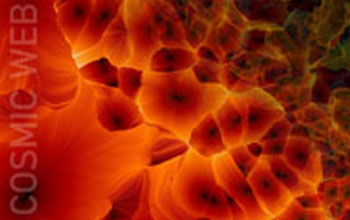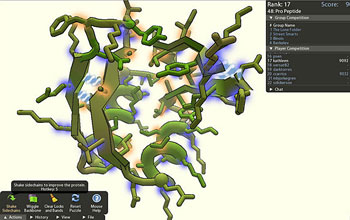All Images
News Release 12-018
2011 International Science & Engineering Visualization Challenge Winners Announced
For the first time, public allowed to vote on entries
This material is available primarily for archival purposes. Telephone numbers or other contact information may be out of date; please see current contact information at media contacts.

This poster shows different aspects of the Cosmic Web, from global to local dynamics, the underlying network of voids, the flows of matter in time, the structures seen in the density field and finally the galaxies we observe. Several techniques are combined that highlight a particular aspect of the Cosmic Web. The streams of matter are shown by high-pass filtering the velocity field and then using an advection process to move particles. The Void network was computed using an algorithm that extracts the topological features in the density field.
Credit: Miguel Angel Aragon-Calvo, Johns Hopkins University
Julieta Aguilera and Mark SubbaRao, Adler Planetarium
Download the high-resolution JPG version of the image. (36 KB)
Use your mouse to right-click (Mac users may need to Ctrl-click) the link above and choose the option that will save the file or target to your computer.

"Exploring Complex Functions Using Domain Coloring," by Konstantin Poelke and Konrad Polthier, Free University of Berlin, received honorable mention th the Illustration category of the 2011 International Science & Engineering Visualization Challenge, sponsored by NSF and AAAS.
Credit: Konstantin Poelke and Konrad Polthier, Free University of Berlin
Download the high-resolution JPG version of the image. (166 KB)
Use your mouse to right-click (Mac users may need to Ctrl-click) the link above and choose the option that will save the file or target to your computer.

Foldit is a game designed to tackle the problem of protein folding. Proteins are small 'machines' within our bodies that handle practically all functions of living organisms. By knowing more about the 3D structure of proteins (or how they 'fold'), scientists can better understand their function, and get a better idea of how to combat diseases, create vaccines, and even find novel biofuels.
Credit: Seth Cooper, David Baker, Zoran Popovic, Firas Khatib, Jeff Flatten, Kefan Xu, Dun-Yu Hsiao and Riley Adams, University of Washington
Download the high-resolution JPG version of the image. (66 KB)
Use your mouse to right-click (Mac users may need to Ctrl-click) the link above and choose the option that will save the file or target to your computer.

The 2011 winners of the International Science & Engineering Visualization Challenge are featured in the February 3, 2012 issue of the journal Science.
Credit: Copyright AAAS 2012
Download the high-resolution JPG version of the image. (1 MB)
Use your mouse to right-click (Mac users may need to Ctrl-click) the link above and choose the option that will save the file or target to your computer.


